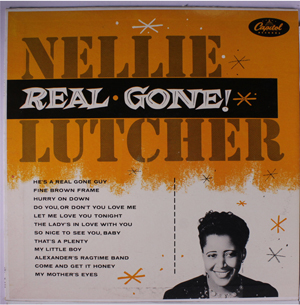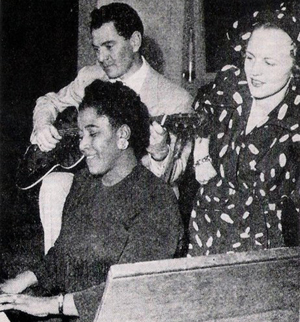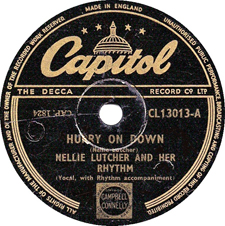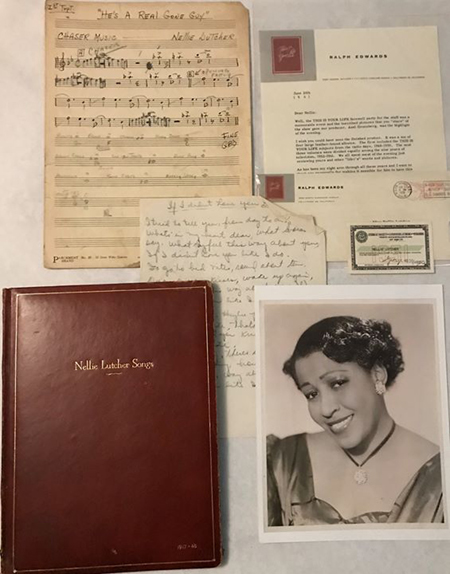Nellie Lutcher. Gone But Not Forgotten
- Details
- Category: Our History
- Published on Monday, 17 April 2017 11:20
- Written by Laura Meyers
Between 1947 and 1950, Lutcher claimed eight million-selling Top Ten hits, and a highly-successful performance stint in London. Her bluesy (sometimes risqué) swing riffs and sly double entendres won her the nickname as the “Real Gone Gal” (from her famous song, “He’s A Real Gone Guy”) in the late 1940s, leading to worldwide tours and singing engagements with Nat King Cole, among others. Lutcher later became the first African American female board member of the Musicians Union Local 47 (American Federation of Musicians).

Lutcher’s style derived directly from the Louisiana rhythm- and-blues idiom epitomized by Fats Domino, Smiley Lewis and others. Her hit records were, in fact, among the first indications of a revolution in public taste, the rise of black rhythm-and-blues.
One music critic once said that her recordings "were among the foundation stones of rock."
But Lutcher disagreed, saying, "I'm a little bit of jazz, a little rhythm and blues. I do pop things and I like ballads. But I don't consider myself anything of rock.”
Lutcher set her sights on a musical career when she was literally still in rompers. Her father was a musician, and her mother bought a piano before Nellie could read or write. By age 8, she was earning $2 a month as an assistant pianist at the New Sunlight Baptist Church in her hometown, Lake Charles, Louisiana. She had to sit on a stack of books just to reach the keyboard. Her father had encouraged improvisation, and Lutcher could play by ear, learning how to alter a melody in unexpected ways.
When Lutcher was 12, and still playing religious hymns at church, Ma Rainey, the Mother of the Blues, came to town. But just before the scheduled performance, Rainey’s piano player went missing. Ma Rainey recruited Lutcher to play.
 Lutcher was hooked. Soon, she left home and went on the road for the next six years traveling in Texas and Louisiana with the Imperial Jazz Band and with the Southern Rhythm Band. By 1930, she had moved to Los Angeles, and landed a job at the Dunbar Hotel, playing the piano in the Dunbar Hotel lounge, until it closed at 2 a.m.
Lutcher was hooked. Soon, she left home and went on the road for the next six years traveling in Texas and Louisiana with the Imperial Jazz Band and with the Southern Rhythm Band. By 1930, she had moved to Los Angeles, and landed a job at the Dunbar Hotel, playing the piano in the Dunbar Hotel lounge, until it closed at 2 a.m.She wasn’t at the Dunbar for long, but the gig did represent a turning point in her career. Up until then, she only played the piano. But the audience kept asking Lutcher to sing. She later recalled, “I’m not a singer. I don’t sing. I just play the piano. But then some people put a glass on my piano and started filling it with coins, saying, ‘sing us a song!’ Finally, I did. The tune was, ‘The Object of My Affection.’ They liked it, and I liked it, so now I was a singer, too.”
Lutcher became friends with, and performed with, many other musicians -- Art Tatum and Nat King Cole, Ivie Anderson, Dootsie Williams and Lena Horne. She played clubs like the Trocadero and Club Alabam, exploring jazz, boogie, Broadway tunes, torch songs, swing, and blues, mixing novelty with sentiment. As a songwriter, she mastered the double entendre; there was a sly and clever element to her lyrics. This was the golden era of singing nightclub pianists, each with a style of her own - among them Rose Murphy, Cleo Brown, Hadda Brooks, and Lutcher.
But Nellie Lutcher wasn’t famous. Yet.
That changed in 1947, when she got her big break. She was “discovered’ – after a quarter century in the business. Lutcher took part in a "March Of Dimes" charity broadcast at Hollywood High School, singing “The One I Love Belongs to Someone Else.”
 Dave Dexter, Capitol Records talent scout, heard her sing, and booked her a recording session. She did four songs, including “Hurry On Down,” her own composition. It was a hit, and sold a million copies.
Dave Dexter, Capitol Records talent scout, heard her sing, and booked her a recording session. She did four songs, including “Hurry On Down,” her own composition. It was a hit, and sold a million copies.
Her second Capitol Records song was “He's A Real Gone Guy,” another million-seller.
Lutcher was promoted by Capitol as "blues with a new bounce" – and she caught the fancy of the general public. She was a tad naughty, a bit ribald, with a husky, playful voice. People said she was “hip,” before it was hip to be hip.
With requests from promoters all over the country, Dexter helped Lutcher sign with a great talent agent, Carlos Gastel, who booked her into much larger clubs, like Manhattan’s Café Society Downtown, headlining with entertainers like Nat King Cole, and Louis Armstrong.
Her fame extended across the ocean at the height of her success. Capitol Records opened a European outlet at the end of 1948. Its first catalogue, published the following year, featured a photograph of Lutcher, "The Real Gone Gal!"
Lutcher became a particular favorite with British audiences, and scarcely a Saturday night went by during 1950-51 without one of the nation's first disc jockeys, Jack Jackson, playing one of her records, usually “Hurry On Down,” “Fine Brown Frame” or “He's A Real Gone Guy.” She was so crazy popular in England that police officers escorted Lutcher to her hotel after a performance to prevent fans from mobbing her.
Lutcher recorded two duets with Nat King Cole, "Can I Come in for a Second?" and "For You, My Love," both in 1950. Two years later, she was the subject of an episode of "This Is Your Life" on television. In 1956, Lutcher appeared on The Today Show, playing during an eight-minute segment.
But opportunities dried up with the emergence of rock 'n' roll, and difficult business experiences made her hesitant to record again. But she didn’t stop performing. Even in the 1980s and 1990s, Lutcher still performed at the Cinegrill, in the Hollywood Roosevelt Hotel. The L.A. Times critic said: “Lutcher has lost none of her exuberance, charm, enthusiasm and sheer, quirky musicality.... Her buoyant sense of swing and the joy which she invests [in] everything she sings, should be part of a required observation course for anyone hoping to become a musical performer."
 Years earlier, Lutcher had invested in real estate, building an apartment building on Van Ness Avenue in the West Adams District. She lived in one unit while renting the other apartments to fellow musicians, including retired Duke Ellington trombonist Lawrence Brown, and also Lil Cumber. That’s where she lived until her death, a decade ago.
Years earlier, Lutcher had invested in real estate, building an apartment building on Van Ness Avenue in the West Adams District. She lived in one unit while renting the other apartments to fellow musicians, including retired Duke Ellington trombonist Lawrence Brown, and also Lil Cumber. That’s where she lived until her death, a decade ago.
Later, when a family member was cleaning out her apartment, many (MANY) of Lutcher’s papers ended up in boxes tossed away on Washington Boulevard and also Venice Boulevard in the Harvard Heights neighborhood. These items – the source of the current exhibit -- were rescued by Billie Green, a local historian, cultural archivist and community activist.
The show runs through to June 10
at the William Grant Still Arts Center
2520 West View St. L.A. 90016
323-734-1165
Tuesday - Saturday Noon - 5 pm
That changed in 1947, when she got her big break. She was “discovered’ – after a quarter century in the business. Lutcher took part in a "March Of Dimes" charity broadcast at Hollywood High School, singing “The One I Love Belongs to Someone Else.”
 Dave Dexter, Capitol Records talent scout, heard her sing, and booked her a recording session. She did four songs, including “Hurry On Down,” her own composition. It was a hit, and sold a million copies.
Dave Dexter, Capitol Records talent scout, heard her sing, and booked her a recording session. She did four songs, including “Hurry On Down,” her own composition. It was a hit, and sold a million copies.Her second Capitol Records song was “He's A Real Gone Guy,” another million-seller.
Lutcher was promoted by Capitol as "blues with a new bounce" – and she caught the fancy of the general public. She was a tad naughty, a bit ribald, with a husky, playful voice. People said she was “hip,” before it was hip to be hip.
With requests from promoters all over the country, Dexter helped Lutcher sign with a great talent agent, Carlos Gastel, who booked her into much larger clubs, like Manhattan’s Café Society Downtown, headlining with entertainers like Nat King Cole, and Louis Armstrong.
Her fame extended across the ocean at the height of her success. Capitol Records opened a European outlet at the end of 1948. Its first catalogue, published the following year, featured a photograph of Lutcher, "The Real Gone Gal!"
Lutcher became a particular favorite with British audiences, and scarcely a Saturday night went by during 1950-51 without one of the nation's first disc jockeys, Jack Jackson, playing one of her records, usually “Hurry On Down,” “Fine Brown Frame” or “He's A Real Gone Guy.” She was so crazy popular in England that police officers escorted Lutcher to her hotel after a performance to prevent fans from mobbing her.
Lutcher recorded two duets with Nat King Cole, "Can I Come in for a Second?" and "For You, My Love," both in 1950. Two years later, she was the subject of an episode of "This Is Your Life" on television. In 1956, Lutcher appeared on The Today Show, playing during an eight-minute segment.
But opportunities dried up with the emergence of rock 'n' roll, and difficult business experiences made her hesitant to record again. But she didn’t stop performing. Even in the 1980s and 1990s, Lutcher still performed at the Cinegrill, in the Hollywood Roosevelt Hotel. The L.A. Times critic said: “Lutcher has lost none of her exuberance, charm, enthusiasm and sheer, quirky musicality.... Her buoyant sense of swing and the joy which she invests [in] everything she sings, should be part of a required observation course for anyone hoping to become a musical performer."
 Years earlier, Lutcher had invested in real estate, building an apartment building on Van Ness Avenue in the West Adams District. She lived in one unit while renting the other apartments to fellow musicians, including retired Duke Ellington trombonist Lawrence Brown, and also Lil Cumber. That’s where she lived until her death, a decade ago.
Years earlier, Lutcher had invested in real estate, building an apartment building on Van Ness Avenue in the West Adams District. She lived in one unit while renting the other apartments to fellow musicians, including retired Duke Ellington trombonist Lawrence Brown, and also Lil Cumber. That’s where she lived until her death, a decade ago.Later, when a family member was cleaning out her apartment, many (MANY) of Lutcher’s papers ended up in boxes tossed away on Washington Boulevard and also Venice Boulevard in the Harvard Heights neighborhood. These items – the source of the current exhibit -- were rescued by Billie Green, a local historian, cultural archivist and community activist.
The show runs through to June 10
at the William Grant Still Arts Center
2520 West View St. L.A. 90016
323-734-1165
Tuesday - Saturday Noon - 5 pm
Categories
-
Architecture
IF ONLY WALLS COULD SPEAK!
 People often think of history as an impersonal collection of facts and dates, a dusty inventory...
People often think of history as an impersonal collection of facts and dates, a dusty inventory...
-
Our History
BRIDGET "BIDDY' MASON: Founder of the First African American Methodist Church FAME
 Originally posted on blackdoctor.orgWhen we talk about Black History, we hear a lot of names over...
Originally posted on blackdoctor.orgWhen we talk about Black History, we hear a lot of names over...
-
In Memory Of
Barbara Morrison Celebrated Jazz Singer Dies at 72
 Barbara Morrison, a legendary singer in the Los Angeles jazz and blues music community, has died....
Barbara Morrison, a legendary singer in the Los Angeles jazz and blues music community, has died....
Today0
Yesterday10
Week41
Month174
All964788
Kubik-Rubik Joomla! Extensions
Yesterday10
Week41
Month174
All964788
Currently are 7 guests and no members online
Kubik-Rubik Joomla! Extensions



